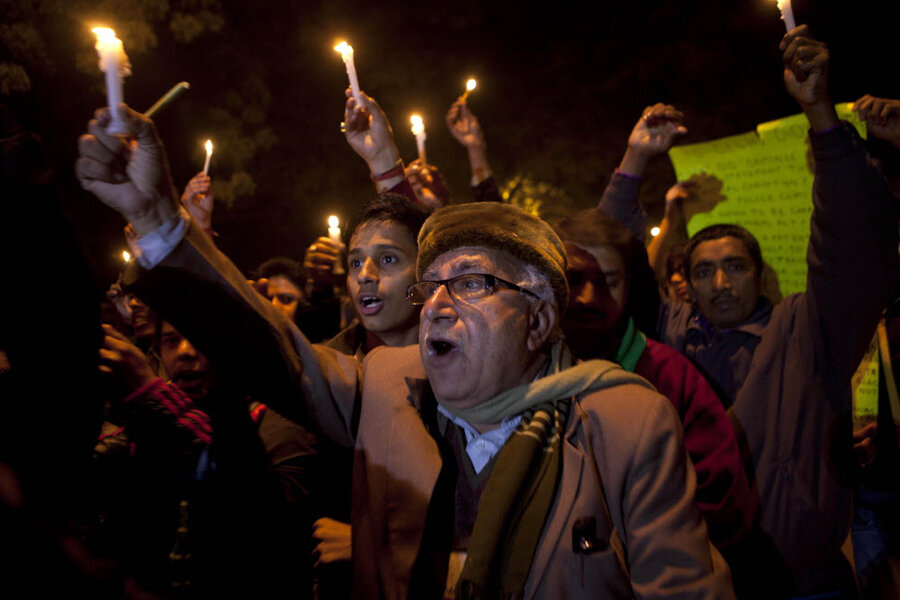Secret cremation for gang-rape victim sparks anger against Indian government
Loading...
| New Delhi
Protests became violent today in Delhi as the youth wing of the opposition Bhartiya Janata Party (BJP) pelted stones at police and tried to climb over barricades following news of the secret cremation of the body of the Delhi gang rape victim.
The young woman was cremated on the outskirts of Delhi Sunday morning in an effort to prevent the public from swarming the funeral site. However, this only increased public resentment, reaffirming the growing perception that the government was being hostile to the protests.
Protests began nearly two weeks ago, after the gang rape and brutal assault of the 23-year-old on Dec. 16, with an outpouring of anger by Indians demanding greater protection for women from sexual violence. Demonstrators marched to Raisina Hill, which houses the presidential palace. There, on the first day of demonstrations a young girl breached security and entered the palace.
As protests became more organized on Facebook and by political organizations, more people took to the streets and the relationship between protestors and police grew more strained.
One protester was filmmaker Anusha Rizvi, who witnessed left-wing groups form a circle and peacefully protest within it. “By afternoon we heard policemen announce loudly in their walkie talkies that they would start charging on the crowd. The regular police went behind and the police criss-crossed through the group of people in the circle.”
The police then charged the crowds with batons, fired tear gas and water canons. The government later said the police had little choice because the protests had become violent. However, many witnesses say the police charged on nonviolent crowds who were sitting on the road.
“I couldn’t see anything. I just heard the two cracks of a split bamboo stick on my back, butt, and thighs. Then I heard the police screaming ... and then I saw a boot kicking my knees and shin,” wrote graphic designer Sangeeta Das in a widely circulated Facebook note.
Lokesh, an activist with the feminist organization Streemukti Sangathan, said that a few people were seen pelting stones out of frustration but the rest tried to stop them. “I don’t know who they were,” she said, “but ... the government was ignoring us and not responding to the protests.”
That the police wanted to disperse the protests and not simply respond to stray stone pelting became clear when it also attacked media personnel and their vehicles, say observers.
“News channels had declined [a] government request to leave the site and [so] they showered our broadcast vans [with a water hose] to make us leave,” said one journalist on condition of anonymity. Another journalist was injured when a tear gas shell exploded near her. The Information and Broadcasting Ministry later issued an “advisory” asking news channels to show restraint with their reporting, threatening action if they didn’t.
Metro stations in central Delhi were closed for nearly a week. India Gate and Raisina Hill were cordoned off from most traffic.
“This is how the government handles public protest across India, even firing directly at protestors and killing them,” says political scientist Nivedita Menon. “Be it agitations against nuclear plants or land grabs, this is the language of the government,” she says echoing the views of many Indians as the protest movement has become as much about police repression as it has been about the safety of women.
To quell popular anger
The government has appointed a special commission designed to give recommendations on how to keep women safe and has made various statements to assuage public anger to little avail.
“The government didn’t have to take the burden of guilt in this case. It could have shared people’s grief,” says political commentator Ajoy Bose, adding that since the anticorruption protests of 2011 the government has showed it has become scared of demonstrations. “There is a huge disconnect between the government and the people, the government no longer knows how to interact,” he said adding that that, too, has angered Indians.
Barkha Dutt, editor of the NDTV news channel, Tweeted, ”From day one the government needed to (and didn't) show Compassion, Communication and Commonsense. Now their attempts seem forced, puny, insincere.”
Still, say some, directing anger at the government is misplaced. “The protestors are taking the easy way out by blaming government apathy. The state only reflects a deeply misogynistic society – the protestors need to look within, not without,” said columnist Mihir Sharma.







